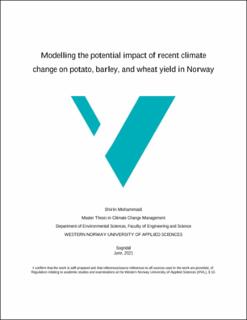| dc.description.abstract | Food security and eliminating hunger are fundamental to fulfilling the global sustainable development goals, but the sensitivity of food production to climate change has made this goal challenging as it accounts for a third of yield reduction for major crops globally. Wheat, barley, and potato are three of the main crops in Norway where their cultivation is limited by low temperature, high precipitation, and limited available land. As the Norwegian agriculture area cannot expand due to limited suitable land, studies are needed to help elucidate the possibilities for improving these crops’ yield by exploiting influential factors, including changes in the climate. In this study, I used statistical modelling of crop yield and climate datasets to evaluate the effect of changes in temperature and precipitation on wheat, barley, and potato yield during 1980–2018 in Norway’s major crop-growing counties. The ultimate aim was to develop models that could help identify the general impact of climate change in Norway and would be useful to help predict future impacts and develop adaptation measures.
The results showed that using a single set of climate predictors for the entire country is challenging, and the impacts of climate variables on wheat, barley, and potato vary widely by county. Meanwhile, it is apparent that some counties should focus on climate change during specific crucial months that correspond with certain crop growth stages. Moreover, it seems that these crops are not under immediate threat from climate change in Norway, and other factors such as policies, management practices, and crop varieties selection are more likely to have had an impact on crop yield during the last 39 years. According to this study, climate change may present opportunities in eastern and southern parts of Norway to grow crops that require higher temperatures and opportunities in the mid and western areas to grow more barley and potato. | en_US |

